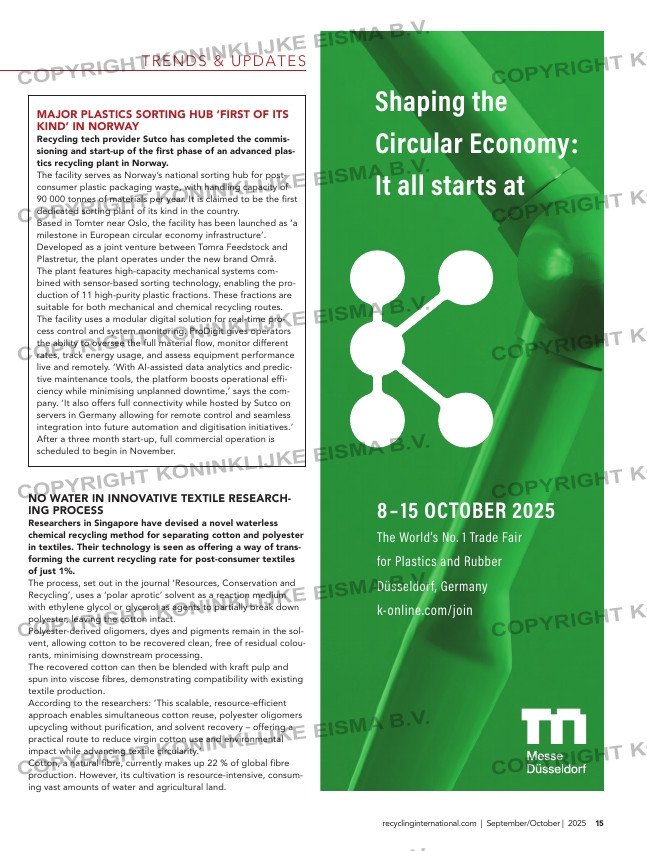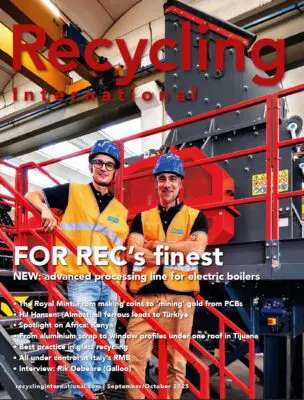Page 15 from: Recycling International September/October 2025

15recyclinginternational.com | September/October | 2025
TRENDS & UPDATES
SWANCOR POWERS CHINA’S FIRST FULLY RECYCLABLE WIND TURBINE
energy. The Taiwanese company launched the resin in 2022.
Glass or carbon fibre composites are recycled through Swancor’s
CleaVER technology. The process turns waste into reclaimed fibres
and oligomers. It effectively closes the loop in the production and
disposal of wind turbine blades.
Unlike other composite recycling methods such as pyrolysis and
solvolysis, Swancor’s system requires no changes to existing blade
production lines, no crushing of fibre-reinforced polymer and gen-
erates no waste solvents or gas. The recycled fibres retain a
mechanical performance equivalent to new fibres and the oligo-
mers can also be reused.
EzCiclo resin is not limited to wind energy. The process can be
applied in automotive, sports and other composite-heavy indus-
tries, addressing broader environmental challenges while minimis-
ing the carbon footprint. It meets RoHS and REACH standards.
The offshore wind blade market is expected to jump from EUR
11.7 billion this year to EUR 41 billion by 2035. From 2030
onwards, carbon-fibre and hybrid designs are expected to gain
market share, enabling larger, lighter rotors of over 100 metres.
Meanwhile, the wind energy recycling market, currently valued at
EUR 55.2 billion, will continue to see ‘robust’ growth. Swancor
hopes its turbine will set a precedent for circularity in the global
wind sector, showing that high-performance, recyclable composites
are feasible at scale.
STADLER delivers high-performance sorting plants for nearly every waste stream — from MSW and plastics
to C&I and e-waste — trusted by recycling leaders worldwide.
End-to-end project support and the advanced digital platform, STADLERconnect, provide real-time
monitoring, predictive maintenance, and smart insights to maximise uptime and reduce costs.
STADLER: For a clean world!
STADLER Anlagenbau GmbH
+49 7584 9226-0
[email protected]
www.w-stadler.de
Designed to Perform. Built to Last.
STADLER Sorting Systems
Shaping the
Circular Economy:
It all starts at
8 – 15 OCTOBER 2025
The World’s No. 1 Trade Fair
for Plastics and Rubber
Düsseldorf, Germany
k-online.com/join
2025-08-22 K 2025_international 2025_Circular Economy_100 x 268_Recycling International_4c_10818.indd 1 03.04.25 14:56
MAJOR PLASTICS SORTING HUB ‘FIRST OF ITS
KIND’ IN NORWAY
Recycling tech provider Sutco has completed the commis-
sioning and start-up of the first phase of an advanced plas-
tics recycling plant in Norway.
The facility serves as Norway’s national sorting hub for post-
consumer plastic packaging waste, with handling capacity of
90 000 tonnes of materials per year. It is claimed to be the first
dedicated sorting plant of its kind in the country.
Based in Tomter near Oslo, the facility has been launched as ‘a
milestone in European circular economy infrastructure’.
Developed as a joint venture between Tomra Feedstock and
Plastretur, the plant operates under the new brand Områ.
The plant features high-capacity mechanical systems com-
bined with sensor-based sorting technology, enabling the pro-
duction of 11 high-purity plastic fractions. These fractions are
suitable for both mechanical and chemical recycling routes.
The facility uses a modular digital solution for real-time pro-
cess control and system monitoring. ProDigit gives operators
the ability to oversee the full material flow, monitor different
rates, track energy usage, and assess equipment performance
live and remotely. ‘With AI-assisted data analytics and predic-
tive maintenance tools, the platform boosts operational effi-
ciency while minimising unplanned downtime,’ says the com-
pany. ‘It also offers full connectivity while hosted by Sutco on
servers in Germany allowing for remote control and seamless
integration into future automation and digitisation initiatives.’
After a three month start-up, full commercial operation is
scheduled to begin in November.
NO WATER IN INNOVATIVE TEXTILE RESEARCH-
ING PROCESS
Researchers in Singapore have devised a novel waterless
chemical recycling method for separating cotton and polyester
in textiles. Their technology is seen as offering a way of trans-
forming the current recycling rate for post-consumer textiles
of just 1%.
The process, set out in the journal ‘Resources, Conservation and
Recycling’, uses a ‘polar aprotic’ solvent as a reaction medium
with ethylene glycol or glycerol as agents to partially break down
polyester, leaving the cotton intact.
Polyester-derived oligomers, dyes and pigments remain in the sol-
vent, allowing cotton to be recovered clean, free of residual colou-
rants, minimising downstream processing.
The recovered cotton can then be blended with kraft pulp and
spun into viscose fibres, demonstrating compatibility with existing
textile production.
According to the researchers: ‘This scalable, resource-efficient
approach enables simultaneous cotton reuse, polyester oligomers
upcycling without purification, and solvent recovery – offering a
practical route to reduce virgin cotton use and environmental
impact while advancing textile circularity.’
Cotton, a natural fibre, currently makes up 22 % of global fibre
production. However, its cultivation is resource-intensive, consum-
ing vast amounts of water and agricultural land.
10-11-12-13-14-15_trendsupdates.indd 15 09-09-2025 09:03



